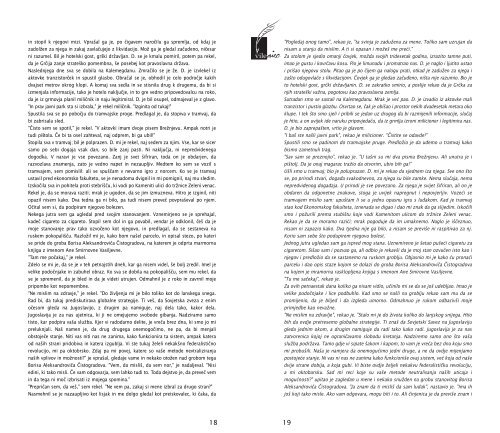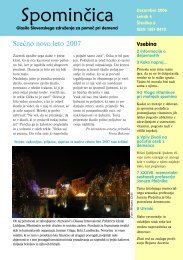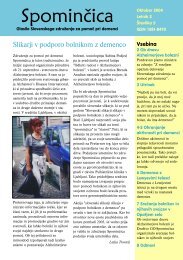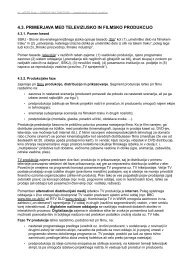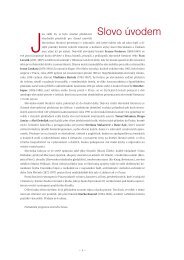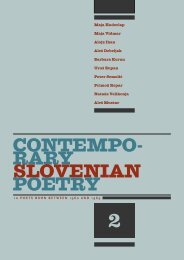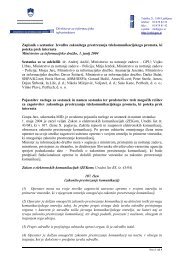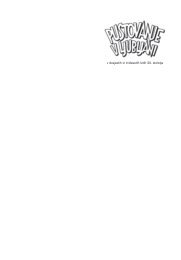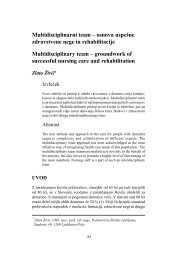Zbornik Mednarodnega literarnega srečanja Vilenica 2003 - Ljudmila
Zbornik Mednarodnega literarnega srečanja Vilenica 2003 - Ljudmila
Zbornik Mednarodnega literarnega srečanja Vilenica 2003 - Ljudmila
You also want an ePaper? Increase the reach of your titles
YUMPU automatically turns print PDFs into web optimized ePapers that Google loves.
Nagrajenec Vilenice <strong>2003</strong><br />
Mirko Kovaè je brez dvoma eden izmed najbolj nadarjenih in izoblikovanih sodobnih<br />
pisateljev s tako imenovanega srbohrvaškega jezikovnega obmoèja nekdanje Jugoslavije.<br />
Rojen je leta 1938 v vasi Petroviæi na meji med Èrno Goro in Hercegovino, kjer je preživel<br />
del otroštva in mladosti, ki sta pogosto prisotna v njegovi literaturi.<br />
Njegova prva knjiga, roman Morišèe, ki je kot mnoga njegova kasnejša dela zaradi<br />
ukvarjanja s tabuiziranimi temami in prikazovanja èlovekovih nagonov, posebno spolnih,<br />
in njegovih nagnjenj k nasilju in zlu razburkala tako literarno kot politièno javnost, je<br />
izšla leta 1962 v Beogradu, kjer je živel vse do leta 1991, ko ga je, zaradi nasprotovanja<br />
Miloševiæu in njegovemu režimu, zapustil in se naselil v Rovinju na Hrvaškem. Leto dni<br />
trajajoèa gonja proti mlademu pisatelju in ostra ideološka in politièna obsodba<br />
njegovega prvenca "zaradi èrne podobe sveta" je potem dolgo vplivala na odnos oblasti<br />
in njenih uslužbencev med literarnimi kritiki do njegovih del. Tarèa tovrstne "kritike" niso<br />
bili le njegovi romani, temveè tudi novele, dramski in esejistièno-publicistièni teksti in<br />
scenariji.<br />
Kovaè je bil ves èas svobodni umetnik, ki je živel za literaturo in od literature. Èeprav je<br />
popolnoma predan besedni umetnosti, ki ne pristaja na vdanost nobeni drugi ideologiji<br />
kot "ideologiji" pripovedovanja oziroma pisanja, s katerim ustvarja poseben, resniènemu<br />
svetu vzporeden svet literature, se je nenehno upiral nasilju in zlu - posebno tistima, ki<br />
so ju zakrivila zlorabljanja vsakršne moèi in oblasti. S tovrstno slo po podrejanju in<br />
unièevanju drugega èloveka se je bojeval predvsem tako, da jo je brezkompromisno<br />
prikazoval.<br />
Njegova proza je najpogosteje sestavljena iz fragmentov razbite podobe znanega sveta,<br />
ki jih je z ustvarjalno domišljijo strukturiral v veèplastni novelistièni ali romaneskni<br />
kolaž. V delih in celoti tega palimpsestnega mozaika se zrcalijo in prepletajo življenjski<br />
kaos in absurdna usoda posameznika, enako surovi zgodovina in vsakdanjost,<br />
resniènost in moreèe sanje ljudi, obsojenih na propad in umiranje. Zato se iz njegovih<br />
novel in romanov neredko razširja vonj po trohnobi in smrti. Toda z opisovanjem<br />
trenutkov, ki jih z lepoto in dobroto obèasno obsije predvsem ljubezen, je hkrati slavil<br />
življenje, ki zanj ves èas ostaja èudež in mistièna skrivnost.<br />
Kovaèev prikaz "grde podobe resniènosti", z gosto stkano mrežo jezika, pokaže pravi<br />
obraz èasa, s katerega je strgal lažno pozlaèeno masko, ki je skrivala razpad moralnih,<br />
nacionalnih, verskih, ideološko-politiènih in drugih vrednot. Predvsem ga razkrije<br />
življenjepis oziroma usoda posameznika, ki je v središèu njegove pripovedne pozornosti.<br />
Posameznika, s katerim upravljajo tako notranje kot tudi enako demoniène zunanje sile,<br />
najpogosteje prikazuje veèstransko, s svetle in temne plati, in ne spregleduje niti<br />
njegovih vrlin niti slabosti, ki se najbolj razkrijejo v razmerju do drugega èloveka,<br />
posebno v tistem, ki izvira iz ljubezni ali sovraštva in ga spodbujajo moène, vèasih tudi<br />
divje strasti.<br />
Pripovedno mojstrstvo Mirka Kovaèa je enega izmed svojih vrhov doseglo v romanu<br />
Vrata materinega telesa, ki je izšel leta 1978. V nagovoru bralcu na zaèetku te obsežne<br />
družinske kronike, ki je naslovljena s sintagmo iz Jobove knjige, sam poudarja<br />
"nagnjenje do razpadljivega življenja". Zaradi tega so ga nekateri razglašali za pisatelja<br />
èrnega vala, drugi pa, kljub takšnim in drugaènim predvsem politiènim diskvalifikacijam,<br />
cenili prav ta temni sijaj njegove literature in ga uvršèali med najpomembnejše evropske<br />
pisatelje. O tem nas preprièuje število prevodov njegovih del v druge jezike in mnoge<br />
pomembne nagrade, ki jih je doslej prejel doma in v tujini. Med drugimi nagrado<br />
Tucholskega, ki jo podeljuje švedski PEN center, in Herderjevo, ki je med<br />
10<br />
Prize-winner <strong>Vilenica</strong> <strong>2003</strong><br />
Mirko Kovaè is beyond doubt one of the most talented and most sophisticated writers<br />
from the so-called Serbo-Croat linguistic region of former Yugoslavia. He was born in<br />
1938 in the village of Petroviæi on the border between Montenegro and Herzegovina,<br />
where he spent part of his childhood and adolescence, which are frequent motifs in his<br />
writing.<br />
Like many of Kovaè's later works his first book, the novel Slaughteryard, disturbed the<br />
literary as well as political public because of the author's preoccupation with taboo<br />
topics and depiction of human base instincts, particularly sexual, and his inclination for<br />
violence and evil. The novel was published in 1962 in Belgrade, where Kovaè lived until<br />
1991, when he left because of his disapproval of Miloševiæ's regime, and settled down<br />
in Rovinj in Croatia. A year-long persecution of the young writer and severe ideological<br />
and political accusations of his first book "because of the black depiction of the world"<br />
had a long-lasting effect on the attitude of the authorities and their officials among<br />
literary critics towards Kovaè's writing. The targets of this "criticism" were not only his<br />
novels, but also short stories, plays, essays and scripts.<br />
Kovaè is a free-lance artist, and he has lived for and by literature all of his working life.<br />
Although totally devoted to the art of words and recognising only one ideology - the<br />
"ideology" of narration and writing, which is the instrument for creating a special world<br />
of literature parallel to the real one - he has constantly fought against evil and violence,<br />
particularly that committed by the misused instruments of power and authority. Kovaè<br />
is fighting against the passion for subordination and destruction of fellow human<br />
beings by pitilessly depicting it.<br />
His prose consists mostly of the fragments of the broken image of the known world,<br />
with creative imagination structured into a multi-layer novelistic collage. The parts and<br />
the whole of this palimpsestic mosaic reflect the chaotic life and absurd fate of the<br />
individual, the equally brutal past and present, reality and nightmares of the people<br />
doomed to destruction and death. This is why his novels frequently give off the putrid<br />
stench of decay and death. However, by depicting moments illuminated by beauty and<br />
love, Kovaè has always glorified life, which for him remains a miracle and a mystery.<br />
Kovaè's rendering of "ugly reality" with a thick-woven web of words reveals the true face<br />
of the time, from which he removed the false gilded mask concealing the decline of<br />
moral, national, religious, ideological, political and other values. Kovaè's centre of<br />
attention is the fate, the life-story of an individual, manipulated by equally demonic<br />
internal and external powers. The hero is most frequently depicted many-sidedly, with<br />
his or her dark and bright aspects, virtues and weaknesses, revealed in the relations<br />
with other human beings driven by love or hate and stimulated by powerful, sometimes<br />
even wild passions.<br />
Kovaè's art of narration has reached one of its peaks in the novel Vrata od utrobe (Door<br />
to the Womb), published in 1978. The prologue to the extensive family saga titled by<br />
the phrase from the The Book of Job emphasises the "tendency towards the decaying<br />
life". This is why some proclaimed Kovaè to be the writer of the black wave, while others<br />
valued the dark tinge of his literature despite all kinds of political disqualifications, and<br />
ranked him among the most important European writers. Proof of the latter is seen in<br />
the numerous translations of his books into foreign languages and several important<br />
prizes at home and abroad, including the Tucholsky Prize awarded by the Swedish PEN<br />
Centre and the Herder Prize, which is among the most prominent literary awards in the<br />
German-speaking world. Even after he had left Belgrade Kovaè continued publishing<br />
11


